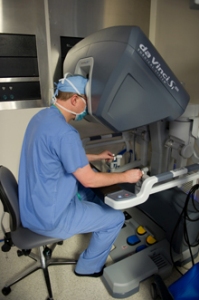Jan 28 2014
A potentially fatal bacterial disease of the heart, infective endocarditis frequently affects the heart's tricuspid valve, often resulting in permanent tissue damage. But a reconstructive technique, in which the valve is repaired with a bioscaffold on which new tissue can grow, can give some patients a new lease on life—a lease that has been extended to patients at Temple University Hospital, in Philadelphia, thanks to the pioneering work of T. Sloane Guy, MD, MBA, Associate Professor of Surgery, Section Chief of Cardiovascular Surgery, and Chief of Robotics at Temple University School of Medicine (TUSM).

Dr. Guy is one of only about a dozen cardiovascular surgeons in the United States who has performed complete tricuspid valve repair procedures using CorMatrix®, an extracellular matrix (ECM) material. In 2013, he became one of the first to perform the reconstruction endoscopically using robotic techniques. He delivered a video presentation of the pioneering procedure on January 27th at the 50th annual meeting of the Society of Thoracic Surgeons (STS), held in Orlando, Florida.
Robotic surgery is a groundbreaking tool in medicine that has been both celebrated for its benefits and criticized for its high cost and high-profile failures. But according to Dr. Guy, totally endoscopic robotic heart surgery not only minimizes the size of incisions made in the chest but also takes advantage of the ability of surgeons, using robotic-assisted tools and techniques, to make high-precision, minute movements, which gives it an edge over traditional techniques.
Recently, Dr. Guy performed a robotic repair by first removing nearly all of the damaged valve from the patient's heart. He then used what he calls the 'cylinder technique' to repair the damaged tissue with a sheet of bioscaffolding that had been fashioned into a tube. The tube effectively served as a new valve.
"We used a CorMatrix® bioscaffold to completely reconstruct the valve," Dr. Guy explained. CorMatrix® bioscaffolds consist of a sheet of ECM, an acellular meshwork of fibers and carbohydrate polymers that facilitates reconstruction by giving patients' own cells a framework on which to build new tissue. Because ECM is made of natural materials, it is eventually replaced by the patient's own cells and absorbed by the body. It also has a low likelihood of rejection, since it does not contain foreign cells or proteins that could precipitate an immune response.
"Temple Cardiovascular Surgery has had a big presence at the meeting this year," Dr. Guy said.